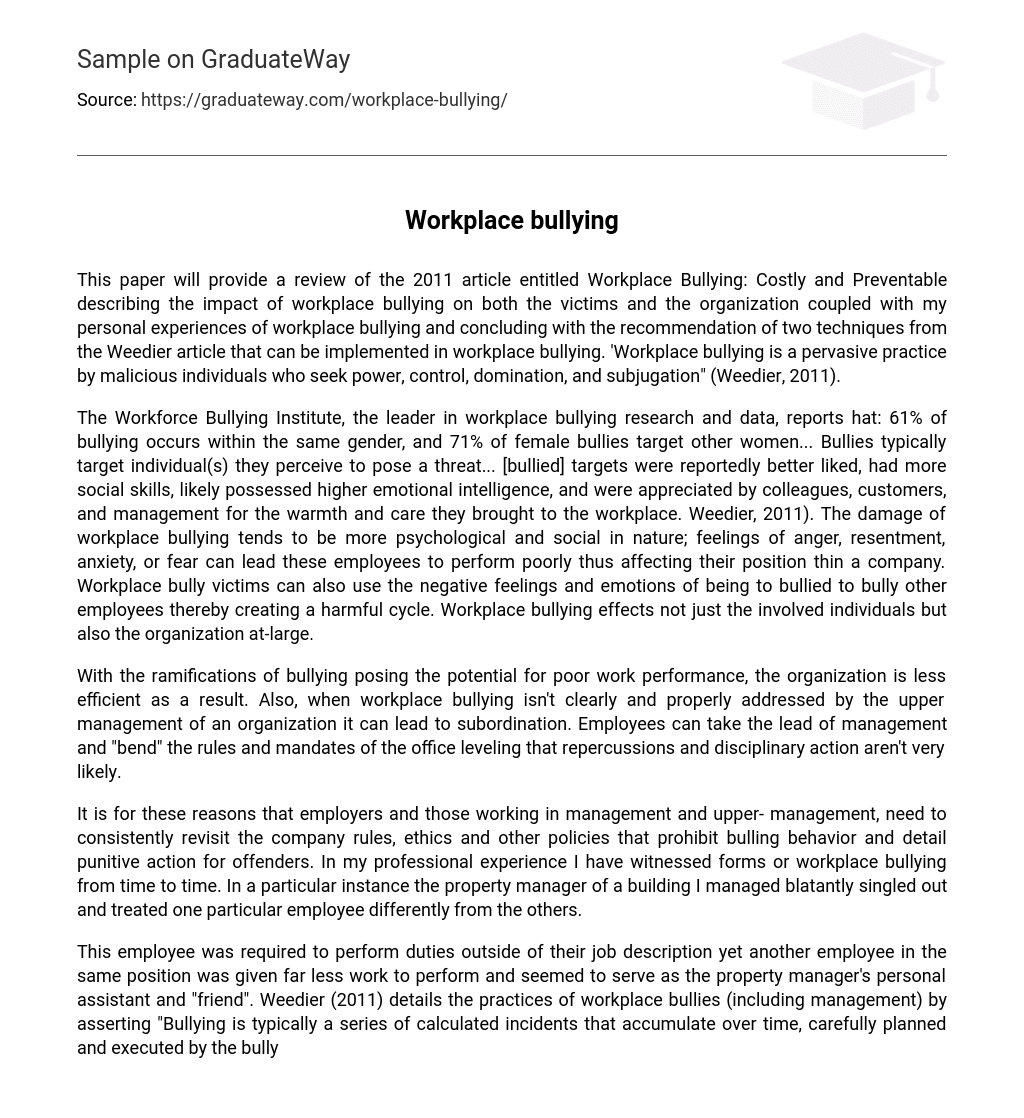This paper aims to analyze the article “Workplace Bullying: Costly and Preventable” from 2011, which explores the impact of workplace bullying on individuals and organizations. It will also share my personal encounters with workplace bullying and conclude by proposing two techniques from Weedier’s article that can be employed to tackle this problem. As stated by Weedier (2011), workplace bullying is a widespread phenomenon in which certain individuals seek power, control, dominance, and subjugation.
The Workforce Bullying Institute, the foremost authority on workplace bullying research and data, states that 61% of bullying happens between individuals of the same gender, and 71% of female bullies focus on other women. Bullies usually target individuals whom they see as threatening. The individuals being bullied were allegedly more popular, possessed superior social skills, likely had higher emotional intelligence, and were admired by colleagues, customers, and management for the kindness and compassion they brought to the workplace (Weedier, 2011).
Workplace bullying has a psychological and social impact, causing employees to experience anger, resentment, anxiety, or fear. These emotions can have a detrimental effect on their performance and position within the company. Additionally, victims of workplace bullying may continue this behavior by targeting other employees, thus creating a harmful cycle. It is crucial to recognize that workplace bullying affects both individuals and the organization as a whole.
The organization becomes less efficient as a result of the potential risks of bullying, which also leads to subordination if not addressed properly by upper management. Employees may follow the example of management and disregard office rules and mandates, knowing that consequences and disciplinary action are unlikely.
Employers and those in management positions must regularly review company rules, ethics, and policies to prevent bullying and clearly outline consequences for offenders. Throughout my professional experience, I have observed instances of workplace bullying. An example of this occurred when the property manager of a building I oversaw explicitly targeted and treated one employee differently than their colleagues.
Despite being required to perform duties beyond their job description, this employee noticed that another employee in the same position had significantly less work to do and appeared to act as the property manager’s personal assistant and “friend”. According to Weedier (2011), workplace bullies, including those in management positions, often engage in a series of carefully planned incidents over time to avoid any legal consequences.
Witnessing workplace bullying can take many forms, and one prime illustration entails a coworker manipulating, distorting, and misrepresenting the words of a fellow employee for personal benefit. Moreover, this particular aggressor was not only guilty of workplace bullying but was also a compulsive liar – fabricating falsehoods about others solely to enhance their own image of competence and superiority. To combat and eradicate instances of workplace bullying, it is imperative to identify and put a stop to these repeat offenders.
Policies, rules, and practices are essential for creating a safe and productive workplace environment (Weedier, 2011). It is important to communicate and enforce these rules and policies with all new hires, discuss them during staff meetings, and prominently display them for all employees. This ensures that employers and businesses can promptly enforce a zero tolerance policy and take disciplinary action against workplace bullying. Another effective approach to combatting workplace bullying is to.
According to Weedier (2011), there is often a significant disconnect between the perceived existence and severity of workplace bullying among employees and employers. Taking proactive measures to address workplace bullying not only establishes a standard within a particular company but also among all staff members. It may appear basic, but by recognizing the cause-and-effect relationship in relation to bullying, employees can understand that their actions lead to disciplinary consequences.





